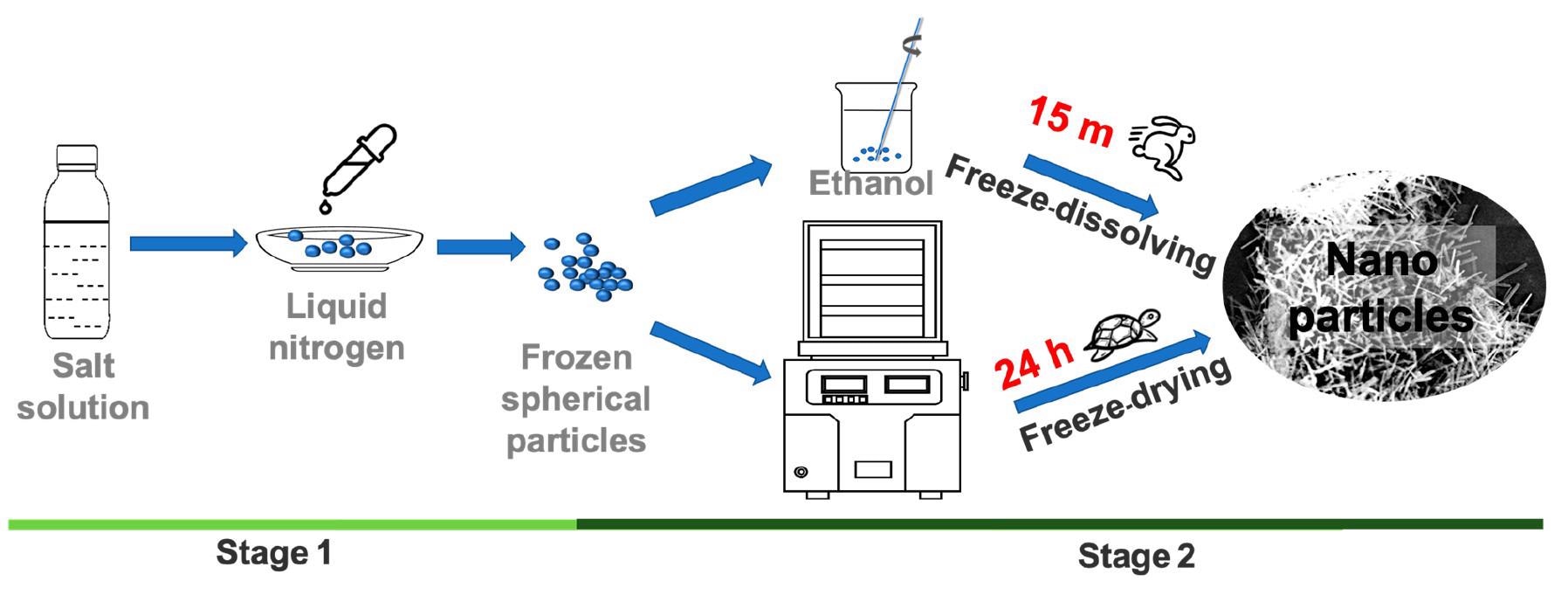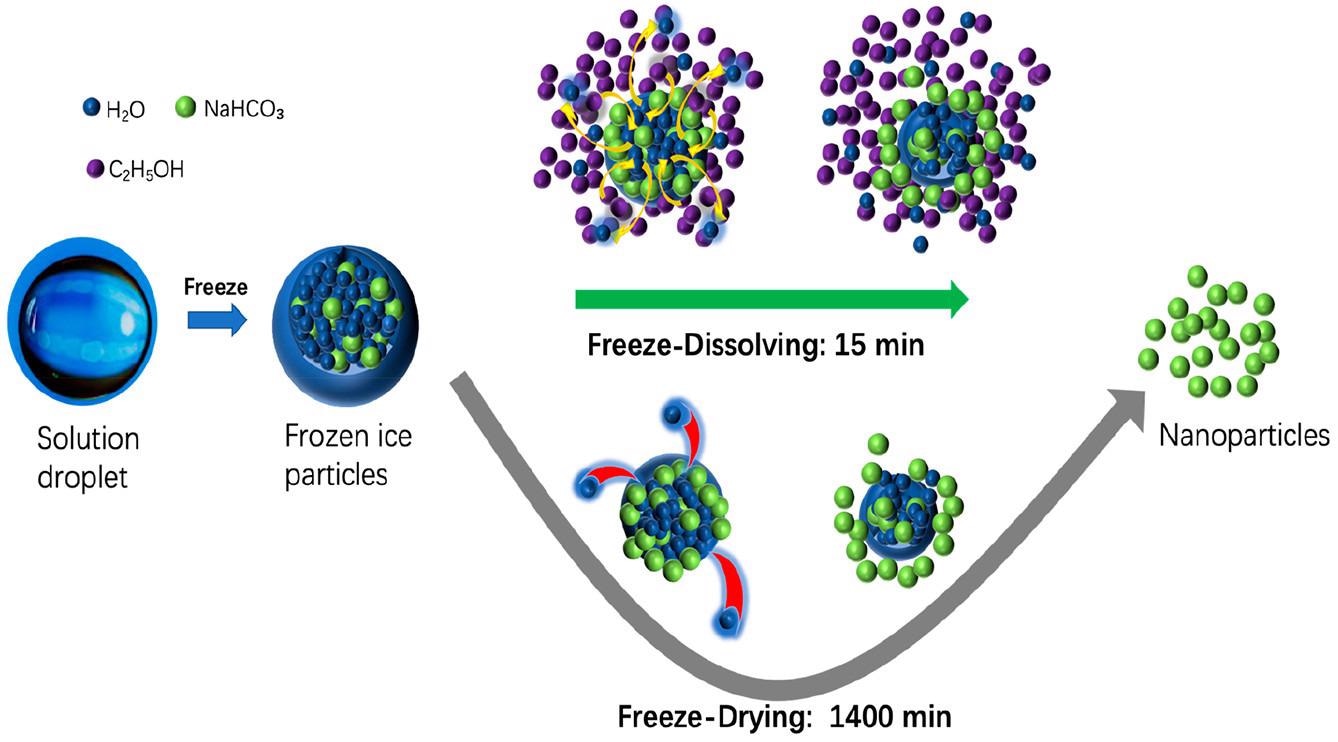A novel freeze-dissolving approach has been devised that offers greater efficiency and sustainability compared to the classic freeze-drying process to make superfine powder or nanoparticles.
In the research published in the journal ACS Sustainable Chemistry & Engineering, sphere-shaped ice particles were formed in an aqueous mixture of NH4H2PO4 or NaHCO3 to produce their respective nanoparticles.
What is the Freeze-Drying Method?
Due to their significant specific areas and strong reactivity, nanomaterials and superfine powders are gaining popularity in fields such as sustainable and environmental applications.
Nanoparticles (NPs) and superfine powders are often produced using freeze-drying techniques. The initial stage in the freeze-drying technique is a cryogenic procedure that freezes target particles or molecules in an aqueous mixture.
In the aqueous mixture, water molecules solidify quickly via the fast-freeze stage, generating a framework of crystallized ice. This step is also referred to as ice templating or freeze-casting. The crystallized ice framework forces the targeted dissolved molecules or components to produce a nanoscale scaffolding architecture, which results in substances with nanoscale or microscale pores.
The freezing stage defines the architecture of the scaffolding and the ice template, as well as the crystal architecture of the targeted substances inside the ice templates or scaffolds, based on the freezing settings.
The second phase is a drying procedure that uses the process of sublimation to separate water as ice templates. The ice melts throughout the drying phase, but the targeted substances, particles, or molecules stay within the ice. From inside the ice, freeze-cast NPs or porous substances with identical architecture and characteristics may be retrieved.

Schematic diagram of experimental setup for the freeze-dissolving method (top) and the freeze-drying method (bottom). © Yu, Q., Wang, Y., Luo, J., & Yang, H. (2022).
Limitations of Freeze-Drying
Due to the cooler temperatures employed in the drying phase, sublimation speeds are sluggish, and batch drying periods for common pharmacological items can take up to multiple days. The production speeds of such batch-based technologies are constrained by poor freeze-drying speeds and extended cycle operation durations.
Some drawbacks may be mitigated by purchasing a bigger freeze-dryer. Unfortunately, it takes much more time to establish perfect vacuum settings, and temperature and pressure are less consistent throughout the container, which could influence output quality. As a result of the cold temperatures and the vacuum arrangement, the drying phase consumes a lot of energy.
How is the Freeze-Dissolving Method Better?
The initial stage in freeze-dissolving is identical to that of freeze-drying, that is, freeze-casting to create ice containing the target components within and build an ice scaffold target architecture.
The ice is then dissolved at a cold temperature, such as a sub-zero temperature in an additional solvent having a low freezing point in the subsequent phase of the freeze-dissolving process. This additional solvent, like ethanol, acts as an antisolvent for the targeted components yet shows miscibility with water.
As a result, the ice scaffold will dissipate fast in the additional solvent, leaving just the targeted components in a solid-state in the mixture, and the architecture of the targeted components produced within the ice will be conserved.
Fire suppression chemicals, baking soda, ammonium dihydrogen phosphate (NH4H2PO4), and sodium bicarbonate (NaHCO3) are water-soluble but do not dissolve in ethanol.
In this work, various quantities of sodium bicarbonate or ammonium dihydrogen phosphate, dissolved in water, were employed to manufacture NPs via the freeze-dissolving technique, which were then evaluated against NPs produced by freeze-drying.

Schematic diagram of the freeze-dissolving and freeze-drying mechanisms for the formation and isolation of NaHCO3 nanoparticles. © Yu, Q., Wang, Y., Luo, J., & Yang, H. (2022).
Important Findings
To extract superfine powder and NPs from ice templates within frozen particles, the proposed freeze-dissolving process offers greater efficiency and sustainability compared to the conventional freeze-drying approach.
Particles of sodium bicarbonate and ammonium dihydrogen phosphate aqueous mixtures were quickly frozen to produce sphere-shaped ice particles, which were then filled with NPs and superfine powder of NaHCO3 or NH4H2PO4.
The frozen components were dispersed in ethanol for 5 minutes at 10 °C using the freeze-dissolving procedure to separate the ice scaffold. The freeze-drying approach, on the other hand, needed 1400 minutes to separate the ice scaffold via the process of sublimation. In identical experimental settings, the dimensions of the end products generated by the freeze-dissolving approach were comparatively small as opposed to those produced by the freeze-drying approach.
The freezing-dissolving approach reported in this study is approximately 100 times quicker and consumes roughly 100 times lesser energy as compared to the freeze-drying approach, without the need for a large facility or a vacuum. As a result, the freeze-dissolving process is likely to be used on an industrial scale with less time, energy, and footprint.
News
Platelet-inspired nanoparticles could improve treatment of inflammatory diseases
Scientists have developed platelet-inspired nanoparticles that deliver anti-inflammatory drugs directly to brain-computer interface implants, doubling their effectiveness. Scientists have found a way to improve the performance of brain-computer interface (BCI) electrodes by delivering anti-inflammatory drugs directly [...]
After 150 years, a new chapter in cancer therapy is finally beginning
For decades, researchers have been looking for ways to destroy cancer cells in a targeted manner without further weakening the body. But for many patients whose immune system is severely impaired by chemotherapy or radiation, [...]
Older chemical libraries show promise for fighting resistant strains of COVID-19 virus
SARS‑CoV‑2, the virus that causes COVID-19, continues to mutate, with some newer strains becoming less responsive to current antiviral treatments like Paxlovid. Now, University of California San Diego scientists and an international team of [...]
Lower doses of immunotherapy for skin cancer give better results, study suggests
According to a new study, lower doses of approved immunotherapy for malignant melanoma can give better results against tumors, while reducing side effects. This is reported by researchers at Karolinska Institutet in the Journal of the National [...]
Researchers highlight five pathways through which microplastics can harm the brain
Microplastics could be fueling neurodegenerative diseases like Alzheimer's and Parkinson's, with a new study highlighting five ways microplastics can trigger inflammation and damage in the brain. More than 57 million people live with dementia, [...]
Tiny Metal Nanodots Obliterate Cancer Cells While Largely Sparing Healthy Tissue
Scientists have developed tiny metal-oxide particles that push cancer cells past their stress limits while sparing healthy tissue. An international team led by RMIT University has developed tiny particles called nanodots, crafted from a metallic compound, [...]
Gold Nanoclusters Could Supercharge Quantum Computers
Researchers found that gold “super atoms” can behave like the atoms in top-tier quantum systems—only far easier to scale. These tiny clusters can be customized at the molecular level, offering a powerful, tunable foundation [...]
A single shot of HPV vaccine may be enough to fight cervical cancer, study finds
WASHINGTON -- A single HPV vaccination appears just as effective as two doses at preventing the viral infection that causes cervical cancer, researchers reported Wednesday. HPV, or human papillomavirus, is very common and spread [...]
New technique overcomes technological barrier in 3D brain imaging
Scientists at the Swiss Light Source SLS have succeeded in mapping a piece of brain tissue in 3D at unprecedented resolution using X-rays, non-destructively. The breakthrough overcomes a long-standing technological barrier that had limited [...]
Scientists Uncover Hidden Blood Pattern in Long COVID
Researchers found persistent microclot and NET structures in Long COVID blood that may explain long-lasting symptoms. Researchers examining Long COVID have identified a structural connection between circulating microclots and neutrophil extracellular traps (NETs). The [...]
This Cellular Trick Helps Cancer Spread, but Could Also Stop It
Groups of normal cbiells can sense far into their surroundings, helping explain cancer cell migration. Understanding this ability could lead to new ways to limit tumor spread. The tale of the princess and the [...]
New mRNA therapy targets drug-resistant pneumonia
Bacteria that multiply on surfaces are a major headache in health care when they gain a foothold on, for example, implants or in catheters. Researchers at Chalmers University of Technology in Sweden have found [...]
Current Heart Health Guidelines Are Failing To Catch a Deadly Genetic Killer
New research reveals that standard screening misses most people with a common inherited cholesterol disorder. A Mayo Clinic study reports that current genetic screening guidelines overlook most people who have familial hypercholesterolemia, an inherited disorder that [...]
Scientists Identify the Evolutionary “Purpose” of Consciousness
Summary: Researchers at Ruhr University Bochum explore why consciousness evolved and why different species developed it in distinct ways. By comparing humans with birds, they show that complex awareness may arise through different neural architectures yet [...]
Novel mRNA therapy curbs antibiotic-resistant infections in preclinical lung models
Researchers at the Icahn School of Medicine at Mount Sinai and collaborators have reported early success with a novel mRNA-based therapy designed to combat antibiotic-resistant bacteria. The findings, published in Nature Biotechnology, show that in [...]
New skin-permeable polymer delivers insulin without needles
A breakthrough zwitterionic polymer slips through the skin’s toughest barriers, carrying insulin deep into tissue and normalizing blood sugar, offering patients a painless alternative to daily injections. A recent study published in the journal Nature examines [...]





















